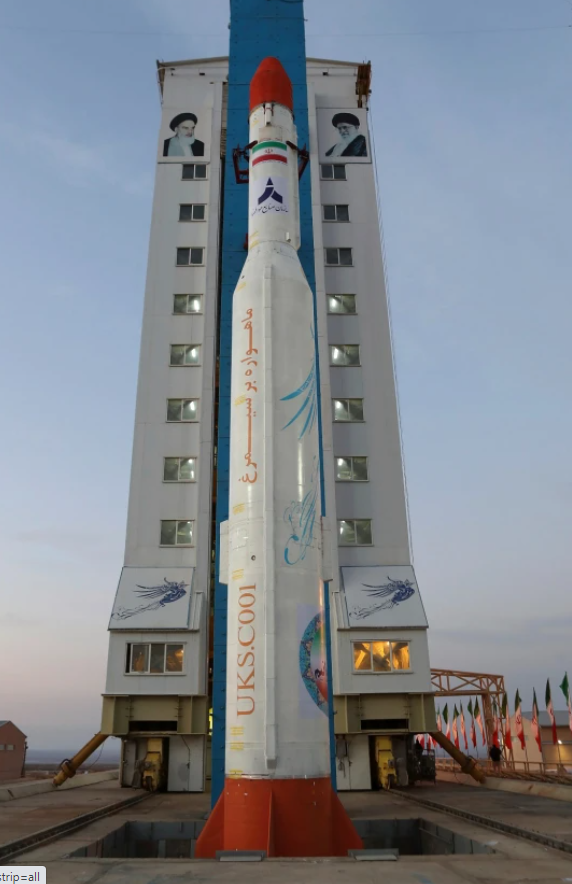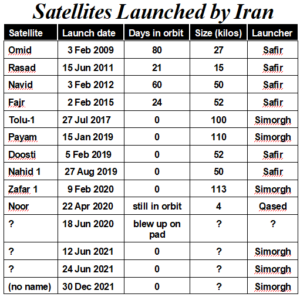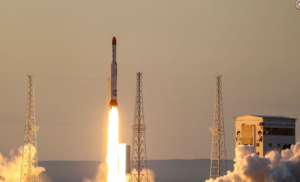December 31, 2021
The Iranian Defense Ministry announced December 30 that it had launched a trio of “research cargoes” into earth orbit—but NASA announced that no satellites ever reached orbit.

preparation tower and is moved to its launch pad.
The failure means that Iran has not succeeded in putting a working satellite into orbit for seven years despite at least 10 attempts.
The US National Aeronautics and Space Administration (NASA) announced hours after Iran’s announcement that no new satellites had been detected entering orbit. It did not say if the rocket launching the “cargoes” had reached orbital altitude or failed earlier in the flight and fallen back back to earth.
Iran’s Defense Ministry did not say if the three “cargoes” where three different satellites or three research programs on one satellite.
It also did not say when it launched the rocket or from where it launched the rocket. Neither did it give a name or names for the satellite(s).
 It said the cargo was launched atop a Simorgh, a three-stage launcher that failed to put satellites into orbit in July 2017, January 2019, February 2020 and twice in June 2021. Simorgh is about triple the size of the Safir, which was used to orbit all four of Iran’s rockets that reached orbit—though none went into a very good orbit and none stayed up longer than 80 days. The Safir rocket was developed by Iran’s civilian space agency.
It said the cargo was launched atop a Simorgh, a three-stage launcher that failed to put satellites into orbit in July 2017, January 2019, February 2020 and twice in June 2021. Simorgh is about triple the size of the Safir, which was used to orbit all four of Iran’s rockets that reached orbit—though none went into a very good orbit and none stayed up longer than 80 days. The Safir rocket was developed by Iran’s civilian space agency.
Ahmad Hossaini, a Defense Ministry spokesman, said, “The performance of the Space Center and the performance of the satellite carrier was done properly.” It was noted that he did not say if the satellite carrier’s cargo was operating in orbit. No claim that a satellite was successfully orbited has yet been made. Nor has there been any acknowledgment of failure.

Since 2015, Iran has tried to orbit nine satellites before this month. Seven never reached orbit, one blew up on the launch pad and the seventh went into orbit but is tumbling and cannot perform any functions.
President Rohani thought the satellite program was a waste of money. Many others viewed it as a wasteful prestige project, just the kind of program that the revolutionaries of 1978 condemned the Shah for pursuing. Rohani tried to bury the program, but was forced to continue it, though he did so at a much lower level of funding.
President Raisi has reversed that. His budget submitted to the Majlis early in December requested that the space budget be increased 12-fold.
The timing of the latest launch may just mean it was the earliest a launch could be scheduled after Raisi took office. However, many analysts speculated Raisi was trying to impress the world in order to gain bargaining leverage in the ongoing nuclear talks.
However, even successfully orbiting a 100-kilo satellite a few hundred kilometers high is not much when compared with Elon Musk sending a multi-ton car into deep space.
The United States opposes Iran’s satellite program, saying that the rocket technology used in satellite launchers overlaps with that used in military missiles. Iran says the technologies used are completely different.
UN Security Council Resolution 2231 of 2015, the one that endorsed the Joint Comprehensive Plan of Action, imposed no ban on rocket launches. However, it said, “Iran is called upon not to undertake any activity related to ballistic missiles designed to be capable of delivering nuclear weapons, including launches using such ballistic missile technology.” It is that language which the United States cites in opposing Iran’s satellite program.
Iran has a solitary small satellite in orbit and still operating. That is Sina-1, which was built and launched by Russia under contract with Iran. It went into orbit October 25, 2005, and recently entered its 17th year in orbit.






















